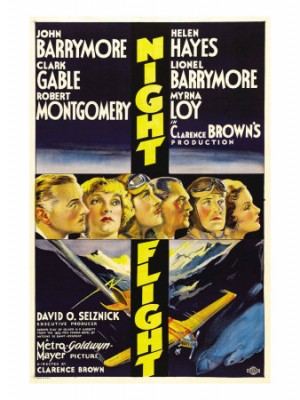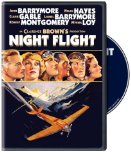| Reviews & Columns |
|
Reviews DVD TV on DVD Blu-ray 4K UHD International DVDs In Theaters Reviews by Studio Video Games Features Collector Series DVDs Easter Egg Database Interviews DVD Talk Radio Feature Articles Columns Anime Talk DVD Savant Horror DVDs The M.O.D. Squad Art House HD Talk Silent DVD
|
DVD Talk Forum |
|
|
| Resources |
|
DVD Price Search Customer Service #'s RCE Info Links |
|
Columns
|
|
|
Night Flight
It's no lost classic, alas. Anyone expecting another Grand Hotel (1932), which Night Flight is clearly patterned after, will be disappointed. But it's unquestionably an interesting picture with bits and pieces that make it worthwhile. Two unremarkable short subjects are tossed in as extra features.
The episodic production traces the first 24 hours of night flight airmail service by the Trans-Andean European Mail Service in South America. The story opens in Rio de Janeiro, Brazil, where an epidemic of infantile paralysis (polio) threatens to get even worse for want of a life-saving serum. There's plenty of medicine in Santiago, Chile, however, and arrangements are made to fly the medicine out on the next flight to Buenos Aires, Trans-Andean's headquarters. The pilot is high-living playboy/deadly serious flyer Auguste Pellerin (Robert Montgomery).
In Buenos Aires, the company's taskmaster managing director, A. Riviére (John Barrymore), stands in front of a huge map of South America, its large bulbs tracing the movements of various flights. The role is not a particularly good one for Barrymore, a cliché even in 1933, his is cut from the same cloth as Warner Baxter in 42nd Street and James Cagney in Footlight Parade, with Riviére working his employees into the ground, outwardly reckless and autocratic while privately struggling with self-doubt, although none about his dreams for nighttime mail flights and their boon to mankind. Lionel Barrymore has even less of a character to play though a bit more to do as company inspector Robineau. Lionel spends most of his screentime madly scratching his eczema-plagued chest.
Elsewhere, pilot Jules Fabian (Clark Gable) and his wireless operator, H. Guimet (Leslie Fenton), have left Punta Arenas, on Chile's southern tip, for Buenos Aires but are soon caught in a fierce rainstorm. Meanwhile, Fabian's wife, Simone (Helen Hayes), nervously waits for his return to Buenos Aires, while the (unnamed) wife (Myrna Loy) of yet another pilot (William Gargan), sadly but resignedly sends her husband off on another dangerous job.
Night Flight partly emulates earlier aerial spectaculars like Wings (1927) and Hell's Angels (1930), but mostly MGM's all-star hit from the year before, Grand Hotel, which likewise starred Lionel and John Barrymore, along with Greta Garbo, Joan Crawford, Wallace Berry, and others. But rather than bring together disparate characters to a single luxurious location, Night Flight spreads them across South America in disconnected footage that suspiciously looks like it was shot piecemeal, as each star had a day or two off. (And it was, at least according to Loy.) Evidence of this is that most of the leading players perform all their scenes on just one or two sets, and there's little interaction among them. Ironically, character actor Frank Conroy (The Day the Earth Stood Still), as the company's worried central radio operator, has more to do than many of the bigger stars.
The parts are clichés when they're characters at all. Helen Hayes's pilot's wife, for instance, at one point has her husband's meal served alongside hers even though he hasn't returned. She tries convincing herself that he's there, conversing with the empty table setting, gradually decides "it won't work" and walks around the room agonizingly, wringing her hands and vying for an Oscar nomination.
Nevertheless, the fact-based setting and harrowing flights made in those early days of aviation are inherently interesting and in 1933 these daring aviators, epitomized by Charles Lindbergh, were justifiably international heroes. The primitive nature of flying back then is pretty amazing. When Fabian and Guimet communicate, they're forced to pass hand-scribbled notes through a little hole near the floor of the fuselage, or close the throttle completely in order to hear each other's voices.
The footage accompanying the night flights is interesting, a mix of beautifully shot aerial footage of silhouetted clouds (taken around Boulder, Colorado), intricate miniatures, and possibly a bit of real footage of South America, though most everything seems to have been shot on soundstages and the MGM backlot. A nice touch is the many high-angle shots looking down on remote homes, fishermen, farmers, etc., as they look up at the passing plane, whose shadow is sometimes a special effect, matted in. The long sequences with Gable and his partner trying to ride out the storm come off best, and the lack of dialog for most of this footage works to its advantage.
Video & Audio
Night Flight is in excellent shape considering its age. The full frame, black and white image is impressively sharp and the contrast is good throughout. The region 1 disc's Dolby Digital mono is likewise fine, and optional English and French subtitles are included.
Extra Features
The only extras are two unspectacular short subjects from the period. The Oscar-nominated Swing High (1932) profiles four generations of trapeze artists, The Flying Codonas, whose real-life exploits weren't quite as happy-go-lucky as smarmy narrator Pete Smith suggests. When the Cat's Away (1935) is a colorful but bland Harman-Ising cartoon in Technicolor.
Parting Thoughts
Worth seeing for its cast, its unusual setting, and for some good flying scenes that compensate for a weak, disconnected script, Night Flight is mildly recommended.
Stuart Galbraith IV's audio commentary for AnimEigo's Tora-san, a DVD boxed set, is on sale now.
|
| Popular Reviews |
| Sponsored Links |
|
|
| Sponsored Links |
|
|
| Release List | Reviews | Shop | Newsletter | Forum | DVD Giveaways | Blu-Ray | Advertise |
|
Copyright 2024 DVDTalk.com All Rights Reserved. Legal Info, Privacy Policy, Terms of Use,
Manage Preferences,
Your Privacy Choices | |||||||














